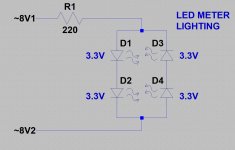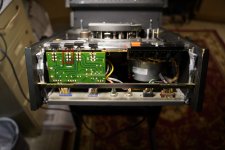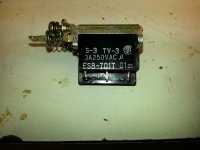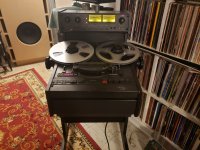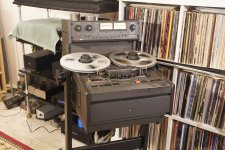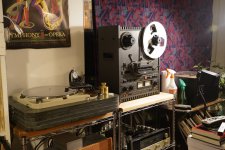I completed some more cap replacements and changed a few things. (Noted in previous post) New photos..
Removed some switches and a few more transistors.
There are a number of shots relating to removal and bypassing of the SEL REP switches (SOS, etc.)
Removed some switches and a few more transistors.
There are a number of shots relating to removal and bypassing of the SEL REP switches (SOS, etc.)
Attachments
-
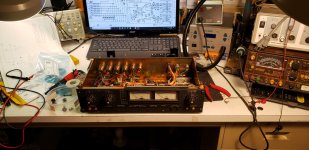 today's done2.jpg702.4 KB · Views: 207
today's done2.jpg702.4 KB · Views: 207 -
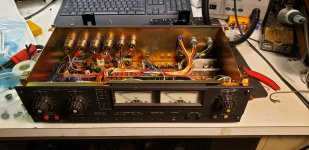 Today's done.jpg657.7 KB · Views: 185
Today's done.jpg657.7 KB · Views: 185 -
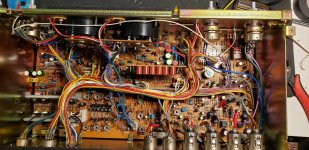 Inside view 1.jpg413 KB · Views: 180
Inside view 1.jpg413 KB · Views: 180 -
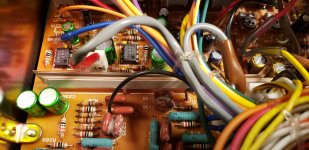 replay output.jpg682.4 KB · Views: 195
replay output.jpg682.4 KB · Views: 195 -
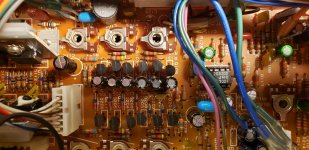 tape replay amp + more recap.jpg681 KB · Views: 369
tape replay amp + more recap.jpg681 KB · Views: 369 -
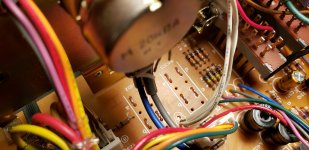 switch mod2.jpg594 KB · Views: 379
switch mod2.jpg594 KB · Views: 379 -
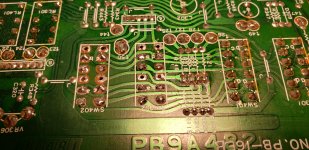 switch mod.jpg928.8 KB · Views: 400
switch mod.jpg928.8 KB · Views: 400 -
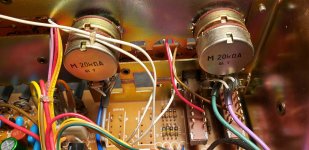 switch and pot mod.jpg612.8 KB · Views: 391
switch and pot mod.jpg612.8 KB · Views: 391 -
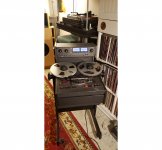 back together2.jpg701.8 KB · Views: 205
back together2.jpg701.8 KB · Views: 205
Otari Switch Problems (Panasonic Switches)
The Panasonic ESB-701T was used to switch power in the MX-5050BII series as well as the MKIII. It was not used in later decks, and was probably used in earlier models not familiar to me.
These switches were used to switch AC power where they usually, but not always hold up well. Where they fair less well is in logic level applications - tape speed/reel size/edit where their use was inappropriate as they were not designed for switching low level signals - predictably the contacts oxidize or the goo they applied to the contacts hardens with age and the low operating currents render the switch inoperable.
These switches were discontinued decades ago, new replacements are almost impossible to find and go for stupid money when you do. Purchasing board assemblies that contain them seems to be the best way to get replacements. This is what I did - the tape speed switch on my MKIII was bad, low speed worked, but high speed was at best intermittent and basically did not work.
Here are some pictures of the switch.
The Panasonic ESB-701T was used to switch power in the MX-5050BII series as well as the MKIII. It was not used in later decks, and was probably used in earlier models not familiar to me.
These switches were used to switch AC power where they usually, but not always hold up well. Where they fair less well is in logic level applications - tape speed/reel size/edit where their use was inappropriate as they were not designed for switching low level signals - predictably the contacts oxidize or the goo they applied to the contacts hardens with age and the low operating currents render the switch inoperable.
These switches were discontinued decades ago, new replacements are almost impossible to find and go for stupid money when you do. Purchasing board assemblies that contain them seems to be the best way to get replacements. This is what I did - the tape speed switch on my MKIII was bad, low speed worked, but high speed was at best intermittent and basically did not work.
Here are some pictures of the switch.
Attachments
Hi Kevin,
You're right. That is a popular old power switch. Power switches are not suitable for switching low currents either. Maybe you can use them to control signal relays? You can use a resistor or light bulb to draw current to make the contacts happier.
I am wishing you luck on this one.
-Chris
You're right. That is a popular old power switch. Power switches are not suitable for switching low currents either. Maybe you can use them to control signal relays? You can use a resistor or light bulb to draw current to make the contacts happier.
I am wishing you luck on this one.
-Chris
Those are good suggestions, but as long as the deck is exercised regularly the switches should continue to function, they made it 35 years and only one has failed in this machine in that time - so while it was an inappropriate choice it hasn't prevented most of these machines from working reliably as long as the switches are exercised.
Otari apparently purchased large quantities of components and continued to use them for years and years until used up. I am not 100% certain but I am pretty sure some of the op-amps were already a few years old when they got into this machine in 1984. Some of the electrolytics had 1980 - 1981 date codes as well.
On op-amps the ones fitted are far from horrible sounding and given the 1970s approach to power supply bypassing (there is no local decoupling anywhere!) and the general design rationalization for lowest cost within the design goals I would be hesitant to advise changing any of the op-amps in this design. (Were anyone inclined the 5532 is pretty forgiving and would provide a small improvement in performance over some of the originals - whether this is audible is anyone's guess.)
I will say the modified and recapped Otari MKIII sounds a lot better than I would have ever expected, particularly considering the generally unpromising condition it arrived in. It's not quite indistinguishable from the source, but it comes a lot closer than the BII with its unmodified audio electronics, and it sounds far better than any of the other decks I've had. The Saki heads undoubtedly contribute as well, will know more when I get the other deck updated and the now spare head stack fitted with refurbished heads.
Otari apparently purchased large quantities of components and continued to use them for years and years until used up. I am not 100% certain but I am pretty sure some of the op-amps were already a few years old when they got into this machine in 1984. Some of the electrolytics had 1980 - 1981 date codes as well.
On op-amps the ones fitted are far from horrible sounding and given the 1970s approach to power supply bypassing (there is no local decoupling anywhere!) and the general design rationalization for lowest cost within the design goals I would be hesitant to advise changing any of the op-amps in this design. (Were anyone inclined the 5532 is pretty forgiving and would provide a small improvement in performance over some of the originals - whether this is audible is anyone's guess.)
I will say the modified and recapped Otari MKIII sounds a lot better than I would have ever expected, particularly considering the generally unpromising condition it arrived in. It's not quite indistinguishable from the source, but it comes a lot closer than the BII with its unmodified audio electronics, and it sounds far better than any of the other decks I've had. The Saki heads undoubtedly contribute as well, will know more when I get the other deck updated and the now spare head stack fitted with refurbished heads.
Hi Kevin,
What op amps did they use? If they are TL072 or TL082, you will hear a difference. Now, since those are FET input op amps, the best upgrade would be OPA2132 (or single / quad) for two op amp packages. Try on one channel near the center of the tape if you want to really see if there is an improvement. If you're ultra stingy, then just the positions that are low level - like the head amp for example. But anywhere you see a TLO7x or TLO8x, you need to replace them with something better. Those did sound better than the 4558 and similar chips, and if you find any of thoser, install NE5532 or NE5534 replacements.. FET to A FET device, BJT to a BJT device.
Don't forget to set the bias oscillator frequency and the bias traps. Misadjusted traps can allow a lot of energy to pound through to the record amp final stage. It doesn't react well to ultrasonic energy and that can cause distortion. I only mention this as many techs skip this step.
The OPA2132 will most definitely make a difference, especially in the head amp position. Just be glad it isn't a 24 track machine! Anything wrong in the tape path at all and that 2" tape is heading off in its own direction.
-Chris
What op amps did they use? If they are TL072 or TL082, you will hear a difference. Now, since those are FET input op amps, the best upgrade would be OPA2132 (or single / quad) for two op amp packages. Try on one channel near the center of the tape if you want to really see if there is an improvement. If you're ultra stingy, then just the positions that are low level - like the head amp for example. But anywhere you see a TLO7x or TLO8x, you need to replace them with something better. Those did sound better than the 4558 and similar chips, and if you find any of thoser, install NE5532 or NE5534 replacements.. FET to A FET device, BJT to a BJT device.
Don't forget to set the bias oscillator frequency and the bias traps. Misadjusted traps can allow a lot of energy to pound through to the record amp final stage. It doesn't react well to ultrasonic energy and that can cause distortion. I only mention this as many techs skip this step.
The OPA2132 will most definitely make a difference, especially in the head amp position. Just be glad it isn't a 24 track machine! Anything wrong in the tape path at all and that 2" tape is heading off in its own direction.
-Chris
All Japanese op-amps which are several notches better sounding than the TL072/82 series stuff you referenced. (No fet op-amps in this design)
Low noise JRC2043 in the tape pre-amp and JRC 4560 which are higher performance cousins (faster, more bandwidth, lower noise) of the 4558/4559 you are probably already familiar with. (They are admittedly mediocre by today's standards, but my history with op-amp upgrades has not been positive - some of the older devices sound just fine and replacing them with more modern ones has not resulted in substantial improvements in sound quality, sometimes unfortunately quite the reverse.)
Given the overall design approach I strongly recommend not changing the op-amps, I think given the complexity of the design and the lack of any decoupling at the op-amps this is just begging for trouble. This is a single sided PCB with relatively mediocre board ground - there are a lot of buss bars for power and ground.
Given the way it now sounds I also don't see a lot of reason to make the change. None of the JRC stuff IMHO is bad sounding - past upgrades of devices like dacs and CD players using these parts did not result in the sort of gains in performance I would have expected.
I suspect in a lot of ways this is a pretty studied design and was the result of a lot of evolution with small changes over the years.
Further improvement is likely possible but I will need to look at what's next.
Edit: You might be surprised but I am not a fan of the OPA2132 sound at all, much prefer the newer OPA1641 and 1642 to the old BB devices. It sounds too warm and slow to me.
Low noise JRC2043 in the tape pre-amp and JRC 4560 which are higher performance cousins (faster, more bandwidth, lower noise) of the 4558/4559 you are probably already familiar with. (They are admittedly mediocre by today's standards, but my history with op-amp upgrades has not been positive - some of the older devices sound just fine and replacing them with more modern ones has not resulted in substantial improvements in sound quality, sometimes unfortunately quite the reverse.)
Given the overall design approach I strongly recommend not changing the op-amps, I think given the complexity of the design and the lack of any decoupling at the op-amps this is just begging for trouble. This is a single sided PCB with relatively mediocre board ground - there are a lot of buss bars for power and ground.
Given the way it now sounds I also don't see a lot of reason to make the change. None of the JRC stuff IMHO is bad sounding - past upgrades of devices like dacs and CD players using these parts did not result in the sort of gains in performance I would have expected.
I suspect in a lot of ways this is a pretty studied design and was the result of a lot of evolution with small changes over the years.
Further improvement is likely possible but I will need to look at what's next.
Edit: You might be surprised but I am not a fan of the OPA2132 sound at all, much prefer the newer OPA1641 and 1642 to the old BB devices. It sounds too warm and slow to me.
For those of you hesitating to participate there are often decks available for short money at electronic flea markets, and hamfests.
A friend of mine recently (just a few weeks ago) acquired two MX-5050 BII series decks at a hamfest for a couple of hundred dollars each. I've not seen them, but I believe they are in a lot better shape than my two freebies were when I got them.
There are often decks offered on eBay that are represented as being in better running condition than typical finds offline. There are some reputable refurbishers selling on eBay as well as private sales. These tend to be a lot more money.
Other sources can be public auctions at radio stations and advertising agencies as well as estate sales. These are a long shot but sometimes machines come out of these for next to nothing. (Mine came from a radio station and advertising agency respectively for next to nothing and were eventually gifted to me by friends looking to free up space at home.)
My plan ultimately for these machines is to use them for casual recording as I see fit, and for playback of commercial studio quality tapes I will start to acquire once I am confident that these machines will play them safely.
A friend of mine recently (just a few weeks ago) acquired two MX-5050 BII series decks at a hamfest for a couple of hundred dollars each. I've not seen them, but I believe they are in a lot better shape than my two freebies were when I got them.
There are often decks offered on eBay that are represented as being in better running condition than typical finds offline. There are some reputable refurbishers selling on eBay as well as private sales. These tend to be a lot more money.
Other sources can be public auctions at radio stations and advertising agencies as well as estate sales. These are a long shot but sometimes machines come out of these for next to nothing. (Mine came from a radio station and advertising agency respectively for next to nothing and were eventually gifted to me by friends looking to free up space at home.)
My plan ultimately for these machines is to use them for casual recording as I see fit, and for playback of commercial studio quality tapes I will start to acquire once I am confident that these machines will play them safely.
M- m- m- must... r- r- resist... urge!
Received a Revox B77 as a radio station refugee around 1989. Wonderful-sounding deck, and mesmerizing to watch, too. Wound up selling it at a hamfest back in 2007 and regretted it ever since.
Don't have much experience with the Otari decks, but if yours sound anything like my old Revox then you've got some keepers for sure!
Received a Revox B77 as a radio station refugee around 1989. Wonderful-sounding deck, and mesmerizing to watch, too. Wound up selling it at a hamfest back in 2007 and regretted it ever since.
Don't have much experience with the Otari decks, but if yours sound anything like my old Revox then you've got some keepers for sure!
Replaced all the caps on the meter boards and swapped out the LEDS for warm white.. (They are very warm, but not quite as yellow as they appear in the photo.
Replaced a few straggler electrolytics. Most of the ones that are left are in the microphone pre-amp and since that is disconnected I think I will leave them as is.
Replaced a few straggler electrolytics. Most of the ones that are left are in the microphone pre-amp and since that is disconnected I think I will leave them as is.
Attachments
For those of you hesitating to participate there are often decks available for short money at electronic flea markets, and hamfests.
hesitating? I'm positively petrified of the ramifactions. I've been resiting R2R since about 1985
Very nice Kevin !
Heard a double stack of MBL,s last year and they had a digital source and reel to reel comparison and it was easy to hear how superior the tape was.
Storage capability of tape is much higher than any digital medium from what I have gathered.
Excellent project
Regards
David
Heard a double stack of MBL,s last year and they had a digital source and reel to reel comparison and it was easy to hear how superior the tape was.
Storage capability of tape is much higher than any digital medium from what I have gathered.
Excellent project
Regards
David
Hi Kevin,
Looks really good now. The blue was ... disturbing.
Op amp[ upgrades have to be done carefully. It's never a deal where you just jam them in there. Today's faster op amps need supply bypassing added for certain. As for the OPA2132, I will often use other op amps if they don't suit the circuit. I never leave them in to charge a customer for unless there is a clear measurable difference and it also sounds better. I also use the JRC parts and they suit some designs better than the BB parts.
In contrast to your findings on BB op amps, I have found about the opposite - as long as they have bypassing and show no signs of instability. Some times the original parts must be used as you have pointed out, and I don't feel that every op amp need to be replaced. I'm spending their money and have to be responsible the way it is spent.
-Chris
Looks really good now. The blue was ... disturbing.
Op amp[ upgrades have to be done carefully. It's never a deal where you just jam them in there. Today's faster op amps need supply bypassing added for certain. As for the OPA2132, I will often use other op amps if they don't suit the circuit. I never leave them in to charge a customer for unless there is a clear measurable difference and it also sounds better. I also use the JRC parts and they suit some designs better than the BB parts.
In contrast to your findings on BB op amps, I have found about the opposite - as long as they have bypassing and show no signs of instability. Some times the original parts must be used as you have pointed out, and I don't feel that every op amp need to be replaced. I'm spending their money and have to be responsible the way it is spent.
-Chris
hesitating? I'm positively petrified of the ramifactions. I've been resiting R2R since about 1985.
Well that was my excuse too, and why originally I got out of R2R tape about 5 years ago, but I got tired of the manifest failings of vinyl and decided to give it another shot. Having a local friend heavily into tape and a couple more in Dallas was a motivating factor.
The machines were free and came from close friends, that said neither of them were in good running condition when I got them. A sizeable investment in time and significant money has been spent. I buy premium tape to record on while I sort out the decks on hand before investing in expensive tape project, ultraanalog or other recorded tapes.
The MKIII-2 is mostly in need now of only minor mechanical TLC and has gotten some. The BII-2 is slightly better condition overall and looks a lot less shop worn. The MKIII needs a serious repaint of some of the panels. It is currently the better sounding of the two machines having gotten just about a full cap refresh, good Saki ferrite heads, and a much needed capstan motor overhaul. It's also now got lit meters!
but I got tired of the manifest failings of vinyl and decided to give it another shot.
I don't get it (maybe it's just me) but there is virtually no prerecorded material available on tape so the point is lost on me.
The selection is limited, but enough is available if you know where to look and are willing to pay for it. My goal is to purchase a couple a year. There are a couple from UltraAnalog and the tape project I plan to purchase, some old studio masters are available on a fortuitous basis.
Catalog | The Tape Project
Home | UltraAnalogue Recordings | Toronto Analogue Recordings of Classical Music
Acoustic Sounds
1/4” Studio Master - ABC(Int`l)Records
This isn't all of them... The elephant in the room is the expense, but I have a few years yet where I can indulge in pointless exercises like tape and more particularly hifi. Compared to what I've spent on the hobby in recent years a few tapes a year is a drop in the bucket.
Stop by sometime, hopefully I will have something besides rips to play by then..
(Needless to say I have heard some really good studio recordings on tape in recent times or I would not be bothering.)
Otaris are very common around here, and broken ones can be cheap or free..(like mine)
Catalog | The Tape Project
Home | UltraAnalogue Recordings | Toronto Analogue Recordings of Classical Music
Acoustic Sounds
1/4” Studio Master - ABC(Int`l)Records
This isn't all of them... The elephant in the room is the expense, but I have a few years yet where I can indulge in pointless exercises like tape and more particularly hifi. Compared to what I've spent on the hobby in recent years a few tapes a year is a drop in the bucket.
Stop by sometime, hopefully I will have something besides rips to play by then..
(Needless to say I have heard some really good studio recordings on tape in recent times or I would not be bothering.)
Otaris are very common around here, and broken ones can be cheap or free..(like mine)
Stop by sometime, hopefully I will have something besides rips to play by then..
Sounds good, but $450 for a vintage Reiner? I would like to hear the difference.
Me too, only way to know whether the high cost is justified by the results. I have heard some awfully good tape, but not here..
It's just funny, but there is something visceral about handling the tape and threading it through the tape path, and make no mistake even my test tapes sound pretty good, and I am not done.. LOL Fast forward and rewind are absolutely frightening, considering how fast it winds it must hit 40mph or so.. (I need to time it)
I landed in the most demanding job I have had in a decade or so and all the pressure is hard to deal with. Tinkering with these machines actually is a good stress reliever, lots of electronics and some interesting mechanical subsystems. In some respects these machines were clearly built to last pretty much forever, they are beyond rugged, and not too hard to work on if you get the underlying philosophy.
It's just fun for a foolish old man...
It's just funny, but there is something visceral about handling the tape and threading it through the tape path, and make no mistake even my test tapes sound pretty good, and I am not done.. LOL Fast forward and rewind are absolutely frightening, considering how fast it winds it must hit 40mph or so.. (I need to time it)
I landed in the most demanding job I have had in a decade or so and all the pressure is hard to deal with. Tinkering with these machines actually is a good stress reliever, lots of electronics and some interesting mechanical subsystems. In some respects these machines were clearly built to last pretty much forever, they are beyond rugged, and not too hard to work on if you get the underlying philosophy.
It's just fun for a foolish old man...
Attachments
- Home
- Source & Line
- Analogue Source
- So you think you want to play with tape: An Otari Story
